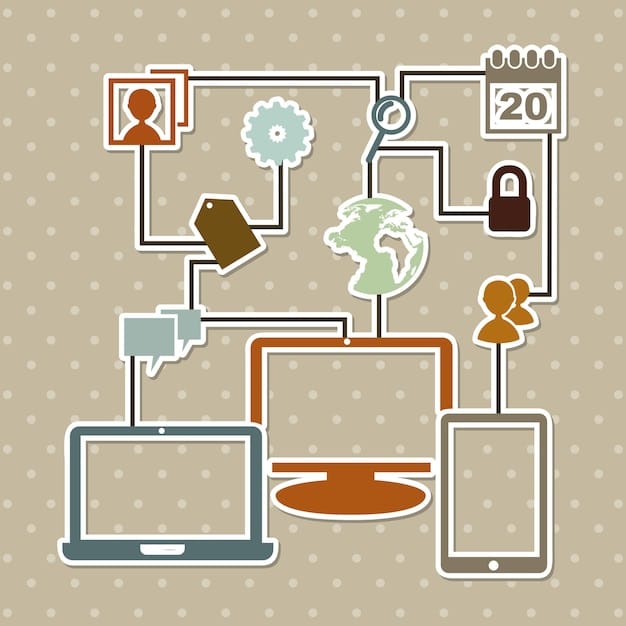Family History Project: Uncover Your Roots & Connect with Generations

Family History Project: Uncover Your Roots and Connect with Generations is a deeply rewarding endeavor, allowing families to explore their lineage, understand their cultural heritage, and create lasting bonds through shared stories and discoveries, revitalizing their sense of identity and belonging.
Embarking on a family history project: uncover your roots and connect with generations, offers a unique opportunity to bridge the past with the present, fostering a deeper understanding of identity and belonging, and bringing enriching, powerful untold stories into the light.
Why Start a Family History Project?
Beginning a family history project can often feel like stepping into a time machine, except instead of looking at dinosaurs, the time machine allows one to understand the people and events that are connected to the family’s past. There are a number of very compelling reasons that doing this can be very emotionally effective.
Strengthening Family Bonds
A family history project is inherently a collaborative activity. It provides a shared goal that family members can work towards together, regardless of age or geographic location.
Discovering Your Identity
Understanding where you come from can have a profound impact on how you see yourself. Knowledge of your ancestors’ sacrifices, triumphs, and struggles can instill a sense of resilience and pride.

Preserving Memories
Otherwise, family stories can fade with time. By documenting these narratives, you ensure that precious memories, traditions, and values are passed down to future generations.
- Learn more about past generations.
- Connect to your roots.
- Understand how you became the person you are today.
Engaging in a family history project isn’t just about documenting names and dates; it’s about discovering the full, vivid scope of where you come from. It can change the way you and your family interact with each other and the world that exists today.
Getting Started: Gathering Information
The first step in any family history project involves gathering as much information as possible from various sources. This stage is crucial for building a solid foundation for your research.
Interviewing Family Members
Start by talking to the oldest members of your family. They often hold a treasure trove of stories, names, and dates that aren’t written down anywhere.
Exploring Home Archives
Search through old photo albums, letters, diaries, and documents in your home. These items can provide valuable clues about your ancestors’ lives.
Utilizing Online Resources
Several websites offer genealogical records, such as census data, birth certificates, and marriage licenses. These resources can help you fill in gaps in your family tree.
- Transcribe oral histories for future generations.
- Take notes of important dates and places.
- Use online tools to digitally archive all physical media.
Having the right information provides the bedrock for constructing the story of your family. Make sure that information is preserved so that as generations pass, they will still be up to date on the family’s past.
Building Your Family Tree
Once you’ve gathered your initial information, the next step is to organize it into a family tree. This visual representation of your ancestry can help you identify patterns and connections.
Choosing a Format
You can create a family tree using pen and paper, specialized genealogy software, or online tools. Choose a format that suits your preferences and technical skills.
Adding Key Details
Include as much detail as possible for each individual, such as full names, birth dates, marriage dates, and death dates. Also, note any significant events or accomplishments.
Collaborating with Family Members
Encourage other family members to contribute to the family tree. They may have valuable information or photos to add.

Whether one uses a handwritten approach using pen and paper, or a digital one using modern genealogical software, it is extremely effective to assemble as much information as possible and organize it so that connections and patterns can be more clearly discerned.
Delving Deeper: Researching Records
To enrich your family history project, it’s essential to delve into historical records such as census data, vital records, and immigration documents.
Accessing Census Records
Census records provide information about where your ancestors lived, their occupations, and their household members. These records are usually available online or at local libraries.
Obtaining Vital Records
Birth certificates, marriage licenses, and death certificates offer crucial details about your ancestors’ lives. You can typically obtain these records from government agencies or archives.
Exploring Immigration Records
If your ancestors immigrated to the United States, immigration records can reveal their ports of entry, dates of arrival, and countries of origin.
As one dives into census records, vital records, immigration records, and city directories, the wealth of information that one collects can be synthesized and organized into a family history project to create a truly fascinating understanding and accounting of the past.
Preserving and Sharing Your Family History
Once you’ve compiled your research, it’s important to preserve and share your family history with future generations.
Creating a Family History Book
Compile your research, photos, and stories into a beautifully designed book. This tangible keepsake can be passed down through your family.
Building a Digital Archive
Create a digital repository of your family history, including scanned documents, photos, and audio or video recordings. This ensures that your research is accessible and preserved for years to come.
Organizing a Family Reunion
Host a family reunion to share your research and celebrate your shared heritage. This is a great opportunity for family members to connect and learn more about their history. The important thing to remember is that this project and its outcomes become an important gift to future generations.
By converting an archive of the family’s history into a book, or creating a digital archive and sharing it using online resources, ensures that years down the line that information and the patterns and important emotional connections will be preserved, thereby enriching the culture of a specific family. Having a reunion also is an effective way to show family members the fruit of that research to generate a shared understanding and sense of culture.
Overcoming Challenges in Your Family History Project
Every family history project comes with its own set of challenges. Here are some common obstacles and strategies for overcoming them.
Dealing with Incomplete or Inaccurate Information
Not all records are accurate or complete. Verify information from multiple sources and remain open to correcting errors as you uncover new evidence.
Finding Difficult-to-Find Records
Searching for records can be time-consuming and frustrating. Be patient and persistent. Try different search strategies and explore alternative sources.
Navigating Conflicting Stories
Family stories can sometimes conflict. Approach these discrepancies with sensitivity and seek corroboration from reliable sources.
Key Project Benefits
- Strengthens bonds and identity.
- Helps you preserve memories.
- Reveals historical documents.
When projects are undertaken, it is rare that one does not find the work riddled with many kinds of obstacles that must be solved and overcome. So it is too in family history projects. The important thing is to be persistent, patient, and understanding of conflicting bits of information.
| Key Point | Brief Description |
|---|---|
| 👨👩👧👦 Family Bonds | Strengthened through shared discovery and storytelling. |
| 🕰️ Memory Preservation | Ensures family stories and traditions endure. |
| 📜 Record Research | Uncovers hidden family history from census, vital, and immigration documents. |
| 💾 Digital Archiving | Keeps research accessible long-term with preservation. |
Frequently Asked Questions
A family history project: uncover your roots and connect with generations, consists of doing archival research and interviews to connect names, documents, records and interviews into a meaningful family narrative.
Begin by gathering all physical and digital materials you and your family possess. These may include but are not limited to: photos, writings, keepsakes, and any other memorabilia.
A project of this kind is extremely valuable as it allows an individual and the family to come to a deeper understanding of past values, achievements, and events that are integral to their identity.
Records can sometimes be found at historical societies, libraries, private companies that provide ancestral research services, as well as government offices.
Digital archives are often an excellent way to preserve digital materials. This can take the form of a private website, an external hard drive, or other preservation tools!
Conclusion
Undertaking a family history project: uncover your roots and connect with generations opens a window not only into the past but also into the understanding of the present and of one’s own identity. While the endeavor has its challenges, the rewards of learning about family, creating a treasured family resource, and building a stronger family culture are immeasurable. It allows one to preserve the past in a way that echoes into the present and future.





